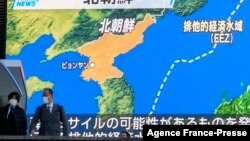North Korea launched a suspected ballistic missile Wednesday, South Korea and Japan reported, Pyongyang’s first weapons test of the new year.
The North fired what appeared to be a single ballistic missile from its northern Jagang Province toward the sea off its east coast, South Korea’s military said. The missile traveled for about 500 kilometers, according to Japanese Defense Minister Nobuo Kishi.
No further details were available. North Korea typically announces its launches in state-run newspapers the following day.
It is North Korea’s first launch since October, when it tested a submarine-launched ballistic missile. The North has frequently tested short-range ballistic missiles since mid-2019, shortly after nuclear negotiations between North Korean leader Kim Jong Un and former U.S. President Donald Trump broke down.
Japanese Prime Minister Fumio Kishida told reporters Wednesday the launches are “truly regrettable.” South Korea’s National Security Council, which held an emergency meeting, also expressed its concerns and emphasized the need to quickly resume talks with North Korea.
The test comes just days after Kim delivered an end-of-year speech that provided few hints about North Korea’s foreign policy direction for this year. Although Kim mostly focused on plans to jump start his country’s economy, he also pledged to continue bolstering national defenses to deal with an “unstable” international situation.
That comment amounted to Kim giving the “signal to resume provocations,” tweeted Jean Lee, a senior fellow at the Wilson Center, a Washington-based research organization.
Other analysts caution that North Korea likely has additional motivations for such a launch, including shoring up domestic political support, testing key new technologies, and demonstrating a deterrence against the U.S. and its allies.
“I question to what extent this is meant for external messaging and how much more this is just a regular part of what they would have done regardless,” says Mason Richey, a professor at South Korea’s Hankuk University of Foreign Studies.
North Korea has not conducted an intercontinental ballistic missile or nuclear test since 2017. Such a move would presumably risk a firmer response by the United States.
Richey says it is unlikely North Korea will dramatically escalate its weapons tests before China, North Korea’s ally and economic lifeline, hosts the Winter Olympics next month.
North Korea is prohibited from any ballistic missile activity, including launches of any range, by a series of United Nations Security Council resolutions. But since 2019, the United States has downplayed the North’s short-range launches, presumably to preserve the possibility for future talks.
North Korea has ignored repeated offers by the U.S. to restart negotiations, saying Washington must first drop its “hostile policy.”
At various points, North Korea has demanded the United States end joint military exercises with its ally, South Korea. It has also called for the U.S. to withdraw troops from the Korean Peninsula. The United Stattes has approximately 28,000 troops in South Korea — a remnant of the 1950s Korean War, which ended in a truce rather than a peace treaty.
On Tuesday, State Department spokesperson Ned Price repeated the U.S. offer to hold talks with North Korea, also known as the Democratic People’s Republic of Korea.
“We’ve made this point repeatedly – but we have no hostile intent towards the DPRK. We are prepared to meet without preconditions. We hope the DPRK will respond positively to our outreach,” Price said at a briefing.
South Korean President Moon Jae-in, who has prioritized talks with North Korea, said Wednesday he would not give up hope for dialogue, despite the latest test.
Moon made the comments at a groundbreaking ceremony for a railroad at an inter-Korean border town that Seoul hopes can eventually cross into the North.





